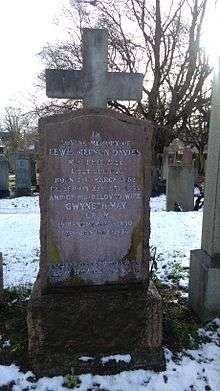Lewis Merson Davies
Dr Lewis Merson Davies FRSE RGS (c.1883–22 September 1955) was a soldier, geologist, palaeontologist and author. He is noted for his controversial re-awakening of anti-evolutionary debate in Britain, following the Scopes Trial of 1925 in USA. He was described as "the most knowledgeable geologist and palaeontologist in the world of creationism".[1] Davies was an advocate of Gap theory, and one of the few geologists to attempt to reconcile issues such as the geological effects of The Flood (as experienced by Noah) with contemporary geological understanding.[2]
In geological terms he specialised in the area then known as the North-West Frontier of India (now Pakistan) and greatly increased the understanding of the Tertiary fauna.[3]
Life

He was born in Nagpur in India in 1882 or 1883 into a British "army family". He began his life as a career soldier, joining the Royal Artillery in 1900 in Britain and returning to join the Indian Army with them in 1907.
In the First World War he had a distinguished record, rising to the rank of Lt Colonel in the Royal Artillery as part of the East Africa Campaign. He was Mentioned in Dispatches and won the Croix de Guerre.[4]
After the war he began writing, mainly on topics concerning Christianity in a scientific world, which linked to his great interest in fossils. His main focus remained the dilemma between Christian beliefs and evolutionary theory, picking up from the Victorian theories of Philip Henry Gosse. In 1930 he was elected a Fellow of the Royal Society of Edinburgh.[5] His proposers were James Ritchie, Murray Macgregor, James Ernest Richey, and Thomas James Jehu.[6] In 1932 he co-founded the Evolution Protest Movement with Douglas Dewar, Bernard Acworth and John Ambrose Fleming (jointly known as the Acworth Circle).[7]
He officially remained in the army until 1933. He then attended University aged 50, graduating with an MA from the University of Edinburgh in 1934, going on to receive both a PhD (1938)[8] and DSc (1941).[9]
In the Second World War he oversaw anti-aircraft batteries involved in coastal defence in the Firth of Forth.
He died in Edinburgh on 22 September 1955 and was buried with his wife, Gwyneth May Davies LRAM (1890-1980) in Grange Cemetery. The grave lies in the modern south-west extension, facing north on the upper section.
The 1976 BBC drama Where Adam Stood parallels his beliefs and dilemmas.
Publications
See[10]
- The Credentials of Jesus (1924)
- The Significance of Modernism (1927)
- The Fossil Fauna of the Samana Range (1930)
- Scientific Discoveries and Their Bearing on the Biblical Account of the Noachian Deluge (1930) (Langhorne Orchard Prize Essay)
- The Dogma of Continuity, The Root of Modernism (1932)
- Tertiary Echinoidea of the Kohat-Potwar Basin (1942) paper to the RGS
- Joseph Needham and the Regnum Dei (1943)
- Evolutionists Under Fire (1944)
- The Bible and Modern Science (1953)
- Is Evolution a Myth? (1957)
- The BBC Abuses Its Monopoly
References
- The Creationists, Ronald L Numbers, p.147
- Formless and Void: Gap Theory Creationism, p15, Tom McIver
- http://eurekamag.com/research/019/318/019318727.php
- London Gazette: 31 August 1917
- "List of Honorary and Ordinary Fellows of the Society elected during Session 1929–1930". Proceedings of the Royal Society of Edinburgh. 50: 404. 1931. doi:10.1017/S0370164600045156.
- https://www.royalsoced.org.uk/cms/files/fellows/biographical_index/fells_indexp1.pdf
- http://dannyreviews.com/h/Creationists.html
- Davies, L. M. (1938). "The Eocene beds of the Kohat district". Cite journal requires
|journal=(help) - Davies, L. M. (1941). "Fossil formaninifera of late cretaceous and early tertiary times, and their significance as strategic indices". Cite journal requires
|journal=(help) - Reconciling Science and Religion: The Debate in Early Twentieth Century Britain, by Peter J Bowler